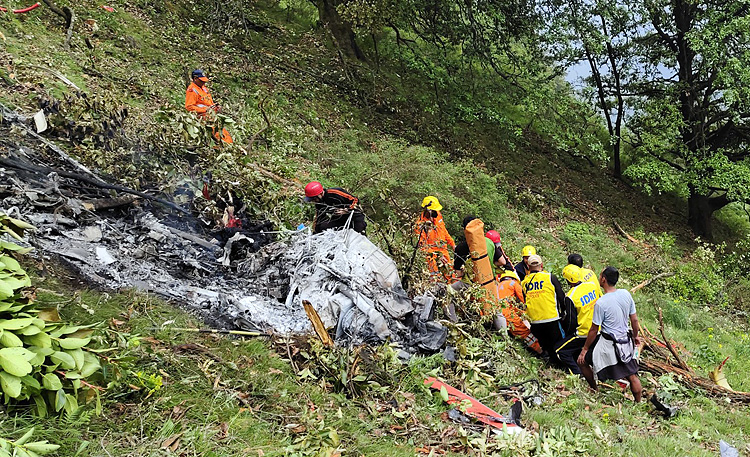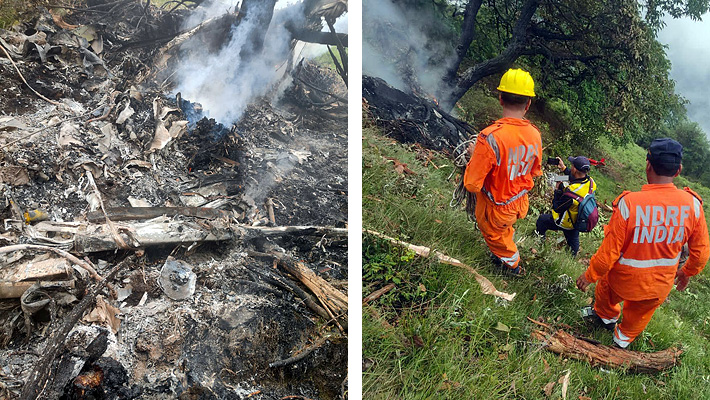Are Safety Norms being Compromised?
Is India's Helicopter boom at the cost of lives? Time for a reckoning on SOPs, safety, and accountability.

The Indian helicopter industry is at a crossroads. On the one hand, it promises exponential growth, with global OEMs eyeing a lucrative market ripe for fleet expansion, civil operations, and regional connectivity. On the other hand, the sector finds itself mired in an unfolding safety crisis, the one that is rapidly shaking public trust and exposing a glaring deficit in regulatory rigour, standard operating discipline, and operational accountability.
In less than 45 days, India has witnessed five helicopter crashes, two of them fatal.
In less than 45 days, India has witnessed five helicopter crashes, two of them fatal. The Char Dham route, in particular, has emerged as a grim epicentre. The recent Kedarnath tragedy, which claimed seven lives, wasn't just an accident. It was the latest evidence of an unspoken rot in the country's general aviation ecosystem, one where following standard operating procedure (SOPs) appear to be optional, penalties are practically non-existent, and regulatory oversight is dangerously cosmetic.
The Culture of Complacency
Let's be blunt: What we are witnessing is the normal operational indiscipline in helicopter services, especially during pilgrimage charters and high-altitude sectors. Many operators, driven by seasonal profits and backed by opaque auditing, seem to treat SOPs more like suggestions than mandates. Are these operators more interested in filling seats than ensuring safety? Is adherence to procedures seen as an obstacle rather than a necessity?
It was the latest evidence of an unspoken rot in the country's general aviation ecosystem, one where following standard operating procedure (SOPs) appear to be optional, penalties are practically non-existent, and regulatory oversight is dangerously cosmetic.
The aviation sector, especially helicopter operations, cannot afford a culture of convenience when it comes to SOPs. Yet, pilots are reportedly being pushed to fly tight schedules with minimal rest, and aircraft dispatches are being cleared in challenging weather with barely a pause for risk evaluation. This isn't operational bravery; it is regulatory negligence hiding behind the veil of commercial urgency.

What must the Ministry do?
Enough with the soft gloves. The Ministry of Civil Aviation (MoCA) needs to stop just issuing statements of "concern" and start acting like the regulator of one of the world's fastest-growing aviation sectors. This means:
- Mandatory Pre-Flight SOP Audits: Before any seasonal route (like Char Dham) is cleared for operation, operators should be made to undergo a comprehensive SOP and safety compliance audit. Every deviation, no matter how small should result in suspension.
- Pilot rostering transparency: A centralised digital log of pilot rosters, flight duty timings, rest hours, and cumulative air-time should be submitted to DGCA in real time. Pilot fatigue has been cited repeatedly as a contributing factor in accidents, and MoCA must not treat this as an internal HR issue for operators.
- Airworthiness in real time: All helicopters operating under scheduled pilgrimage charters must be fitted with health monitoring systems that report aircraft status directly to the regulator. Surprise checks must become routine.
- Seasonal licensing conditions: Charter licenses must be provisional and granted only for fixed intervals, with performance audits acting as gateways to continued operation. One red flag, and licenses should be suspended until revalidation.
- Impose Penalties that matter: Right now, the only real consequence for a crash is a few headlines, a grounded pilot, and a delayed investigation report. That must change. MoCA and DGCA need to treat this with the seriousness it deserves:
- Serious financial penalty for SOP breaches that endanger lives.
- Permanent blacklisting for repeat offenders. Even criminal proceedings in cases of wilful negligence.
- Naming and shaming of negligent accountable managers and directors.
- Pilot and passenger compensation guarantees linked to operator accountability, not insurance red tape.
Many operators, driven by seasonal profits and backed by opaque auditing, seem to treat SOPs more like suggestions than mandates.
This is not about a mechanical failure here or pilot error there. These are systemic cracks in a system too comfortable with risk and too afraid to disrupt the status quo.
Apathy towards human life?
Every time a crash occurs, we mourn. We launch inquiries. We announce compensations. But has a single operator been permanently grounded for recurring safety violations? Have regulatory officials been held accountable for their oversight failures? The industry behaves as if human lives are an acceptable collateral for seasonal profits.
This is not about a mechanical failure here or pilot error there. These are systemic cracks in a system too comfortable with risk and too afraid to disrupt the status quo.
In a country that prides itself on rapid infrastructure growth and increasing connectivity, should safety really be an afterthought? MoCA needs to break out of its slumber and shake up the existing framework.
India's Helicopter market: Skyward, but at what cost?
India is on the cusp of a helicopter revolution. From medevac services to regional air mobility and last-mile cargo delivery, the market is expected to grow substantially in the next decade. The government has even envisioned heliports under the UDAN scheme to improve regional access.
No amount of fleet expansion, foreign investment, or market optimism can compensate for a single lost life especially when death was preventable.
But if our current safety protocols remain patchy and loosely enforced, this expansion will be built on an extremely fragile foundation. We must ask: is this growth coming at the cost of safety? At the cost of lives?
No amount of fleet expansion, foreign investment, or market optimism can compensate for a single lost life especially when death was preventable.
Final Descent: A call for urgency, not optics
The Char Dham helicopter tragedy must not become just another grim statistic. It must become a turning point. For regulators to enforce, for operators to introspect, and for the public to demand more.
The writing is on the wall. If India wants to be a global aviation leader, it must earn it, not just with numbers, but with accountability.
Because in aviation, a checklist skipped isn't just a rule broken, it is a life lost.





